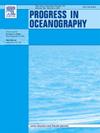北印度洋秋季季风间期颗粒有机质C:N:P比值的下降
IF 3.6
3区 地球科学
Q1 OCEANOGRAPHY
引用次数: 0
摘要
最近的研究描述了海洋中浮游植物对环境和生物因子的化学计量(C:N:P)依赖性,并将这些发现用于全球气候模型。然而,由于观测不足,模式对低纬度地区的预估在很大程度上仍然不确定。本文研究了包括孟加拉湾和阿拉伯海在内的北印度洋在秋季季风间期颗粒有机物(POM)的区域尺度化学计量学变化。阿拉伯海(126:24:1)和孟加拉湾(148:25:1)的POM平均C:N:P比低于北印度洋其他季节。虽然N:P和C:P比值保持不变,但C:N比值在盆地顶层(阿拉伯海表层至25-60 m,孟加拉湾表层至42-60 m)呈现变化。我们认为原绿球藻和聚球菌控制了孟加拉湾的C:N比,而阿拉伯海的营养和温度调节了C:N比。与预期的低营养条件下C:N比值(8-9)升高相反,该比值接近Redfield比值(6.6)。C:N比值的下降可能与秋季季间浮游生物群落中异养细菌(C:N = 3.8 ~ 4.5)的优势有关。本文的分析可用于评价温度、养分和浮游生物群落组成对生物地球化学元素循环的区域重要性。本文章由计算机程序翻译,如有差异,请以英文原文为准。
Decline in C:N:P ratios of particulate organic matter during the fall intermonsoon in the northern Indian Ocean
Recent studies have delineated the stoichiometric (C:N:P) dependency of phytoplankton on environmental and biological factors in the ocean and leveraged these findings in global climate models. However, model projections for low latitude regions remain largely uncertain due to insufficient observations. Here, we have investigated the regional scale stoichiometric variations of particulate organic matter (POM) in the northern Indian Ocean, encompassing the Bay of Bengal and the Arabian Sea, during the fall intermonsoon. The mean C:N:P ratios of POM in the Arabian Sea (126:24:1) and in the Bay of Bengal (148:25:1) were lower than those during the other seasons in the northern Indian Ocean. While N:P and C:P ratios remain invariant, C:N ratio showed variation in the top layer across the basins (surface to 25–60 m in the Arabian Sea and surface to 42–60 m in the Bay of Bengal). We suggest that the Prochlorococcus and Synechococcus control the C:N ratio in the Bay of Bengal, while nutrients and temperature regulate the ratio in the Arabian Sea. Contrary to the expected increase in C:N ratio (8–9) in oligotrophic conditions, the ratio was close to the Redfield ratio (6.6). The decrease in C:N ratio could be attributed to the heterotrophic bacterial (C:N = 3.8–4.5) dominance in the plankton community during the fall intermonsoon. Our analysis might be useful in evaluating the regional importance of temperature, nutrients, and plankton community composition on biogeochemical elemental cycling.
求助全文
通过发布文献求助,成功后即可免费获取论文全文。
去求助
来源期刊

Progress in Oceanography
地学-海洋学
CiteScore
7.20
自引率
4.90%
发文量
138
审稿时长
3 months
期刊介绍:
Progress in Oceanography publishes the longer, more comprehensive papers that most oceanographers feel are necessary, on occasion, to do justice to their work. Contributions are generally either a review of an aspect of oceanography or a treatise on an expanding oceanographic subject. The articles cover the entire spectrum of disciplines within the science of oceanography. Occasionally volumes are devoted to collections of papers and conference proceedings of exceptional interest. Essential reading for all oceanographers.
 求助内容:
求助内容: 应助结果提醒方式:
应助结果提醒方式:


